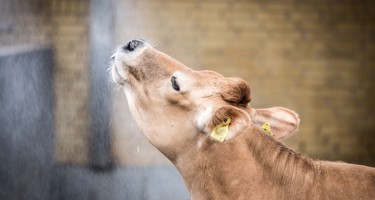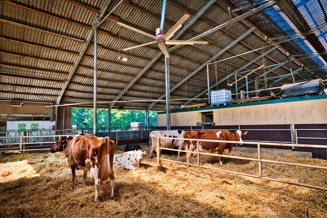
Have you ever wondered what the life of a cow is like? Or how dairy cows are treated? Here are a few insights and facts about animal welfare of Arla cows and dairy cows in general. Do they have access to grass? What weather do they prefer? And what are the cows’ living conditions like?
Cows on grass
Most people can agree that cows on grass are a delight to see, especially when they are let out in the big green pastures on the first day of the grazing season. If you do not know what we are talking about, check out this video:
But are all dairy cows on grass? Not all of them. Should they be? Not necessarily.
It depends on the conditions at the individual farm, and it is not necessarily a bad thing if cows are not on grass. For many cows, living in open-barn systems may be just as good or even better as they can be sheltered from the sun and hard weather, receive good healthcare and have good and healthy feeding options.
The most ideal condition for a cow is when the temperature is around 10 degrees. Very few cows like rain, strong winds or heat. If the weather is too hot or rainy, a cow will often prefer to stay indoors.
In order to have cows on grass, it is crucial that that the cows are able to find shade and shelter and that the soil is not too full of stones or muddy as this can be harmful to cows’ hooves. It is also important that the grass field is within a reasonable distance from the stable so the cows can be fed and milked on time. Most cows are milked twice a day.
Are Arla cows on grass?
All cows on Arla’s more than 900 organic farms are on grass from April to November, which is in accordance with the EU organic legislation. Approximately 50% of the total cows on conventional Arla farms graze outdoors during summer when weather and field conditions allow it. The number, however, varies from country to country. In Sweden, for example, national regulations say that all cows should be on grass. Whereas in Germany, approximately 25% of conventional Arla cows are on grass. In the UK, the majority of the conventional cows are out on pasture during the summer months.
It is up to the individual conventional farmer to assess whether they want their cows to graze in the summer months. This largely depends on whether the farmer has suitable fields and whether it is practically feasible in relation to the milking process.
An increasing number of Arla farmers are investing in new open-barn systems. In these, the cows have a good physical environment where they can, for example, freely walk around, be milked by milking machines when they feel like it, socialise, sleep, eat and groom, massage or scratch themselves on one of the cow brushes in the barn.
What does a cow do all day?
A dairy cow spends its life doing five things:
- sleeping,
- eating,
- ruminating (chewing the cud),
- being milked
- and socialising with the other cows in the herd.
A cow needs 12–14 hours of rest per day, which makes it crucial for cows to be able to lie down in a comfortable spot. All Arla cows have access to lie down in the barn. This is one of numerous requirements in our farm management programme, ArlaGården®.
The material of the cow’s bed varies from barn to barn. Some farmers prefer sand beds for their cows, while others choose waterbeds. The most important thing about the bed is that it gives the cow a nice place to rest, which is also important for its milk production.
Most open-barn systems have a roof and open sides. This ensures that the cows get fresh air, shelter and a dry resting area regardless of the weather. This gives the cows an experience of being outside and farmers can easily care for their health and provide them with good feeding options. In Sweden, some barns are more closed to protect the cows from the cold weather.

Today, there is a lot of research into what the cows themselves actually prefer when they have free access to both the barn and the field. A research from the University of Wisconsin for example found that cows were more likely to go outside during the night and spend the daytime inside. When it was raining, they stayed inside.
Tracking and measuring on cows’ welfare
Animal welfare is a core value of Arla and we have set up specific rules and check systems beyond what is legislatively required to ensure good conditions for the cows. Not only do Arla farmers follow the law in their respective countries in terms of both conventional and organic milk production, but on top of that, Arla has specified requirements for animal welfare in the quality assurance programme “Arlagården®”, which all Arla farmers must adhere to.
Based on scientific research, the extra requirements measure the wellbeing of the cows using four indicators:
- Body condition
- Mobility
- Injuries
- Cleanliness
Every quarter, Arla farmers assess and report on animal welfare where they systematically score their cows within these four areas. If the ArlaGården® requirements are not met, prompt actions are taken to ensure the welfare of the cows.
Read more about the four areas here
Also read: What is animal welfare - in milk production?